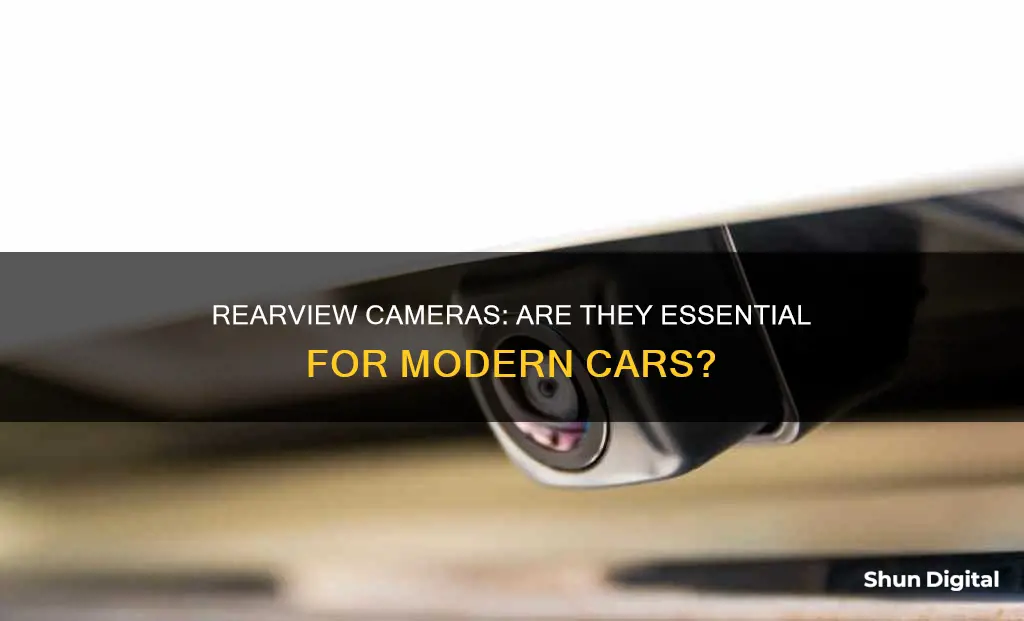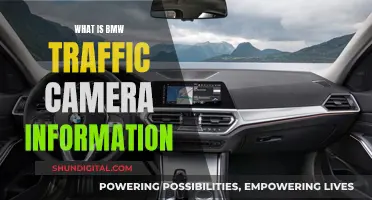
Rearview cameras are a valuable addition to any car, providing increased visibility and safety for drivers. While some may consider them unnecessary, there are several compelling reasons to install a rear-facing camera in your vehicle. Firstly, they offer a more comprehensive view of your surroundings, capturing up to 50% more of the road than a front-facing dash cam alone. This extended field of vision can be crucial in preventing accidents and providing evidence in the event of an incident.
In addition to enhancing safety, rear dash cams can also provide peace of mind and protect you from false insurance claims. They are particularly useful in hit-and-run scenarios, where capturing a clear image of a license plate or a driver's face can make all the difference in an investigation. With the cost of backup camera systems dropping and their effectiveness proven, it's a worthwhile investment for any car owner.
| Characteristics | Values |
|---|---|
| Legality | Since May 2018, all new cars sold in the US have been required by law to have rear-view cameras. |
| Safety | Rear-view cameras can save lives, especially those of children and seniors, by improving visibility and reducing accidents. |
| Cost | Rear-view cameras are inexpensive, with some models costing under $50. |
| Ease of Installation | Wireless models can be bolted to the license plate, while wired models may be less convenient to install but offer battery-free operation and larger screens. |
| Insurance | Some insurance companies offer safety feature discounts for cars with rear-view cameras. |
| Functionality | Rear-view cameras can be activated automatically when the vehicle is placed in reverse, and may superimpose an outline of the car's size on the feed. |
| Other Benefits | Rear-view cameras can help with parking, and may also deter tailgaters and bad behaviour from other drivers. |
What You'll Learn

Rear cameras can help with insurance claims
Rear-view cameras are now mandatory in all new vehicles in the US and Canada. While they don't directly lower insurance costs, they can be incredibly useful if you're ever involved in an incident on the road.
Evidence for Insurance Claims
A rear-facing camera can capture incidents that happen behind your car, such as someone running into the back of you or a hit-and-run driver damaging your vehicle. This footage can be used as evidence when taking drivers to court or making an insurance claim.
Proving Fault
In the case of a road accident, who's to blame isn't always clear. Dashcam footage can give a clear and unbiased record of exactly what happened, which makes it easier to figure out who was at fault. This can save everyone time, hassle, and money.
Protecting Your No-Claim Discount
Being able to provide dashcam footage could speed up the time it takes to settle your claim. It can also help you avoid paying for an incident that wasn't your fault. If you're found to be at fault, you could lose some or all of your no-claim discount, and claims can negatively affect your premium when it's time to renew.
Preventing Fraud
So-called 'crash for cash' cases have been on the rise in recent years, where another driver brakes suddenly in front of you so that you crash into them, and then they claim against you. With dashcam footage, it's easier to prove that you were the victim, not the perpetrator.
Surveillance Cameras: Accurate or Invasive?
You may want to see also

They can save you money by preventing accidents
Rear-view cameras are a valuable safety feature that can help prevent accidents and save lives. They can also save you money by reducing the risk of accidents and associated costs.
One of the main benefits of a rear-view camera is that it provides a broader field of vision, eliminating blind spots and enhancing visibility of obstacles, pedestrians, and other vehicles when reversing. This can be particularly useful when parking in tight spaces or manoeuvring in a crowded lot. By improving visibility, rear-view cameras can help drivers avoid collisions, thus reducing the likelihood of costly repairs, insurance claims, and potential increases in insurance premiums.
In addition to preventing accidents, a rear-facing camera can also capture footage of incidents that occur behind your vehicle. This can include hit-and-run incidents or instances of road harassment, providing valuable evidence for insurance claims or legal proceedings. The presence of a rear-facing camera can also act as a deterrent, discouraging bad behaviour from other drivers.
While rear-view cameras offer many benefits, it is important not to rely solely on them. Drivers should also utilise their side mirrors, review mirrors, and their own observations when reversing. Additionally, rear-view cameras may not always provide a comprehensive view of the surroundings, particularly below the trunk level. Therefore, it is crucial for drivers to remain vigilant and actively scan their surroundings to ensure a safe driving experience.
Overall, while rear-view cameras can provide significant benefits in terms of safety and cost savings, they should be used in conjunction with other safety measures to ensure maximum protection on the road.
Understanding Bulb Mode: Long Exposures Explained
You may want to see also

They can help you park more safely
Rear cameras are incredibly useful when it comes to parking more safely. They are now standard in all new cars in the US and many other countries, and for good reason. They can help you park more safely by providing a clear view behind your vehicle, making reversing into tight spots or parallel parking much easier. This is especially true at night or in adverse weather conditions, where visibility is often compromised.
A rear camera can also help you avoid obstacles while reversing, saving your car from scratches, dents, and even serious crashes. They can eliminate blind spots, providing a wider field of view than mirrors and helping you see exactly what's behind your car. This is particularly useful when parking in busy areas with lots of pedestrians, as it can help prevent injuries or fatalities caused by backing-up accidents.
Some rear camera systems also come with on-screen parking assistance features, like static or dynamic guidelines that adjust as you turn the steering wheel. This can be a huge help when manoeuvring into tricky parking spaces.
In addition to improving safety, a rear camera can also provide peace of mind. If an accident does occur, a rear camera can capture footage that can be used as evidence, helping to prove your innocence in a crash. This can be invaluable when dealing with insurance companies and can save you a lot of hassle and money in the long run.
While there may be some drawbacks to rear cameras, such as potential driver distraction and limited blind spot coverage, the benefits of improved safety and visibility when parking far outweigh the risks. Overall, a rear camera is a valuable tool that can help you park more safely and confidently.
Charging Drift HD Camera Batteries: A Step-by-Step Guide
You may want to see also

They can deter bad driver behaviour
Rear-view cameras are now a legal requirement in the US and Canada, and some insurance companies offer discounts for cars with this feature. They are a safety measure, helping to reduce accidents and prevent injuries and fatalities when reversing. They are particularly useful in addressing blind spots and improving rear visibility for drivers.
Rear-facing cameras can also deter bad driver behaviour. For example, if a driver is harassing another car on the road, a rear-facing camera can capture the incident and provide evidence of the other driver's behaviour. This can be useful in the case of an accident or other incident. Additionally, some drivers have reported that tailgaters tend to back off when they spot a rear-facing camera, making a rear-end accident less likely. The presence of any dash cam can also discourage bad behaviour from other drivers who don't want to be caught on video.
Dash cams can also be used to monitor your own driving habits. If you find yourself frequently getting angry or aggressive behind the wheel, the footage can help you see what might be causing the problem so that you can work on fixing it.
Charging Camera Batteries: Wedding Photography Essentials
You may want to see also

They can capture amazing footage of the world around you
Rear-view cameras are not only useful for safety reasons but can also be used to capture stunning footage of the world around you. While driving, you might come across breathtaking views that you would want to capture and share with your friends and family. A rear-facing camera can help you do just that.
A rear dash cam can help you capture footage of everything happening around you. Whether it's a stunning sunset, a beautiful mountain view, or a gorgeous shot of the ocean, a rear dash cam can help you record these memories.
In addition to the natural scenery, a rear dash cam can also capture unexpected events such as meteor showers and other natural occurrences. You can also use the rear dash cam to record your car karaoke sessions or other fun moments during your road trips.
The footage captured by a rear dash cam can be easily accessed and reviewed through a smartphone app or the camera's display screen. This makes it convenient to review and share your favourite moments from your road trips.
The rear dash cam not only enhances your safety on the road but also provides you with a tool to capture and share your experiences and memories with others. It allows you to focus on the drive while still being able to record and relive the beautiful moments you encounter during your journey.
So, while a rear dash cam is not necessary in the sense that you can drive a car without it, it can certainly add value to your driving experience and provide you with a unique perspective of the world around you.
Is Your Computer Camera On? Check Now!
You may want to see also
Frequently asked questions
Yes. Rear-view cameras are legally required as standard equipment in all new cars since 2018. They improve the field of vision by 300% compared to a traditional rear-view mirror, helping to save lives and prevent accidents.
Rear-view cameras provide increased safety and visibility when reversing, parking, or driving. They can help prevent accidents, particularly when backing up, and make it easier to manoeuvre in tight spaces. Additionally, they can provide evidence in the event of a collision or insurance claim.
In the United States, backup cameras are required on all new passenger vehicles, trucks, buses, and multipurpose passenger vehicles with a gross vehicle weight rating (GVWR) of 10,000 pounds or less. This requirement has been in effect since May 1, 2018.
While a front-facing dash cam is essential, a rear dash cam is not mandatory but can provide additional benefits. It can capture footage of incidents that occur behind your vehicle, such as hit-and-run accidents or road harassment. A rear dash cam can also deter tailgaters and encourage safer driving behaviour from those around you.







